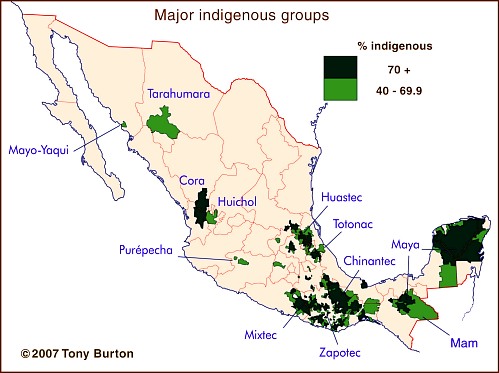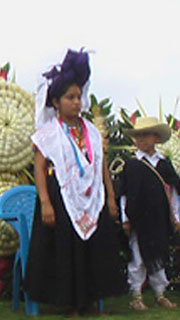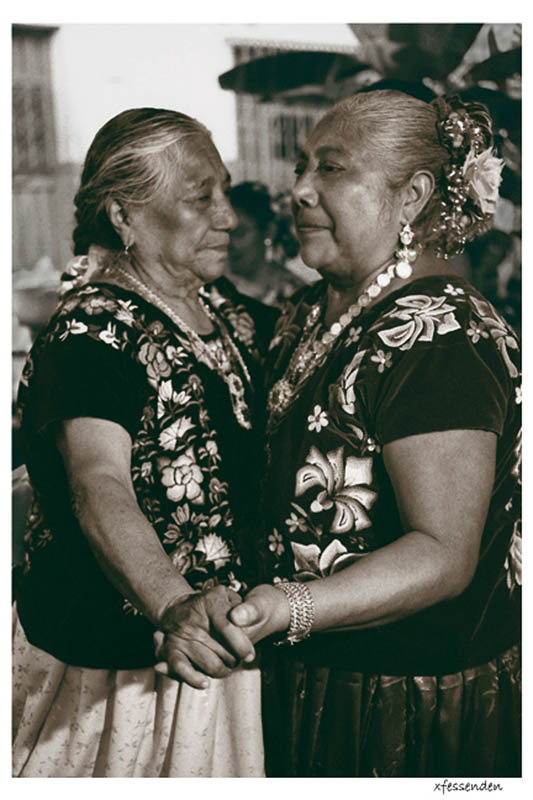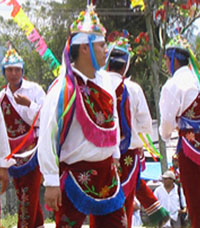
The most recent census count in Mexico reveals that a multitude of languages are used by Mexican nationals throughout the country. It is true that the percentage of Mexicans who are speaking indigenous languages is steadily declining, but a great many people have held on to their mother tongues, sometimes taking it with them to other parts of Mexico.
1. Náhuatl
1,376,026 Mexicans speak twenty-eight Náhuatl languages and live in every state of Mexico. Náhuatl speakers make up 22.89% of all indigenous speakers in the country and are most prominent in several eastern states, including Puebla (28.9% of all Náhuatl speakers), Veracruz (23.2%) and Hidalgo (15.8%).
2. Maya
The Maya language is the second most commonly spoken language in Mexico. In all, 759,000 persons speak Maya, representing 12.63% of the entire indigenous-speaking language. Almost 70% of these people live in Yucatan State, but many others live in Campeche, Quintana Roo and a multitude of other states where they have migrated to in recent decades.

3. Mixteco
In 2005, it was believed that 423,216 Mexicans spoke one of the 57 Mixtec languages, representing 7.04% of all indigenous speakers. Mixtecs are unique in that they have migrated in large numbers to every corner of the Mexico and to many areas in the U.S. Although they are found in every state in significant numbers, the Mixtecs are indigenous to two Mexican states: 57.2% of the Mixtecs live in Oaxaca and 26.1% live in neighboring Guerrero.
4. Zapoteco
It was estimated that 410,901 persons spoke one of the 64 Zapotec languages of México, representing 6.84% of all indigenous speakers. Zapotecs have also migrated to areas throughout Mexico and can be found in every state. However, the largest number of Zapotecs lives in the state of their origin, Oaxaca, where 86.9% of all Zapotecs live.
Many people wonder how so many Zapotec and Mixtec languages evolved from the same origin. But, if one understands the topography of Oaxaca, it makes sense. Oaxaca is characterized by numerous valleys and mountains, which tend to separate closely related peoples. Over time, people who once spoke the same language become separated from one another and their languages evolve until finally, a new language comes into existence. This is, in fact, a very simple explanation for what is a very complex evolution that may take place over hundreds or thousands of years.
5. Tzeltal
In 2005, 371,730 persons spoke the Tzeltal language, representing 6.18% of all indigenous speakers in Mexico. Although Tzeltals have migrated to other parts of México, 97.6% of their members still live in their homeland state of Chiapas. Tzeltal and its close cousin, Tzotzil, are both Mayan languages.

6. Tzotzil
The Tzotzil are close cousins of the Tzeltal who also inhabit Chiapas. In 2005, 329,937 Tzotzil speakers were estimated in Mexico, representing 5.49% of all indigenous speakers. Like their cousins, the Tzeltal, the vast majority of Tzotzil (97.3%) lived in Chiapas.
7. Otomí
In 2005, 239,850 persons in Mexico spoke this widely dispersed language, representing 3.99% of all the indigenous speakers. Approximately 34.8% of the Otomís live in the State of Mexico, but large numbers also inhabit Puebla, Veracruz and many other states in the central and eastern regions of México. Many Otomís traveled north with the Spaniards in the early colonial period and settled in some areas of Jalisco, Nayarit and Guanajuato, but many of them assimilated and did not hold onto their language and culture. The Otomí language is part of the Oto-Manguean linguistic group.
8. Totonaca
The Totonaca language was spoken by 230,930 persons in 2005, representing 3.84% of the indigenous speakers in Mexico. This language is a language that is not closely related to the other common languages of Mexico but has made its imprint in the eastern regions of Mexico. Two states have the largest shares of Totonaca speakers: Veracruz (50.3%) and Puebla (42.0%).
9. Mazateco
The Mazateco language was spoken by 206,559 individuals in 2005, accounting for 3.44% of the indigenous speakers. Mazateco is spoken in several states, but is most predominant in Oaxaca, where 79.7% of the Mazateco speakers resided in 2005. Significant numbers also live in Puebla, Veracruz and the State of Mexico. The Mazateco language is part of the Oto-Manguean Linguistic group (as are the Zapotec, Mixtec and Popoloca languages).
10. Chol
A total of 185,299 persons in Mexico spoke the Chol language in 2005. This represents 3.08% of all indigenous speakers in the country. Chol is a Mayan language that is spoken primarily in Chiapas, where 87.3% of the Chol speakers lived.
11. Huasteco
In 2005, 149,532 persons in Mexico spoke the Huasteco language, making up 2.49% of all indigenous speakers. Huasteco is a northern extension of the Mayan language group. Speakers of this language are clustered in a three-state region that includes Tamaulipas, San Luis Potosi and Veracruz. The majority of Huasteco speakers live in San Luis Potosi (58.9%) but 33.8% also live in Veracruz.
12. Chinanteca
In 2005, 125,706 persons in Mexico spoke one of the 14 Chinanteca languages. They represented 2.09% of all indigenous speakers in Mexico and, like their distant Oto-Manguean relatives (the Zapotecs and Mixtecs), their people have migrated to many parts of the country. However, 81.7% of Chinanteca speakers lived in Oaxaca in 2005, and a considerable number inhabit Veracruz.
13. Mixe
The Mixe language is an isolated language that is primarily spoken in Oaxaca. In 2005, 115,824 persons spoke Mixe, representing 1.93% of the indigenous speakers in Mexico.

14. Mazahua
The Mazahua tongue is a northern extension of Oto-Manguean language, which was spoken by approximately 111,840 Mexicans in 2005, representing 1.86% of all indigenous speakers. The Mazahua language is most commonly spoken in the State of Mexico, where 85.3% of its speakers live.
15. Purépecha
The Purépecha people — sometimes referred to as the Tarascans — are a unique people and the only indigenous group that consistently defeated the Aztecs in battle. Their language is a language isolate which seems to have no known affiliation with any other Mexican languages. Some researchers have suggested a South American origin. At any rate, 105,556 Mexicans spoke Purépecha in 2005, representing 1.76% of all indigenous speakers. Purepéchas have migrated all over Mexico in search of gainful employment, but their strong family ties and cultural pride has maintained Michoacán as their primary home base. Approximately 91.9% of all Purépecha live in Michoacán.
16. Tlapaneco
The Tlapanecos in Guerrero are very similar to the Purépecha of Michoacán. They too speak a language isolate, with no close affiliation with neighboring languages. The Tlapanecos also held out against the Aztecs and lived in a small enclave that resisted Aztec intrusions for more than a century. Their original homeland was a small area that lies completely within the present-day boundaries of Guerrero. As a result, 93.5% of all Tlapaneco’s lived in Guerrero in 2005.
17. Tarahumara
The Tarahumara of Chihuahua are famous and well-known to many Americans who have journeyed south of the border to visit these intriguing people. In 2005, 75,371 persons spoke Tarahumara, representing 1.25% of all indigenous speakers. Although 96.1% of these people lived in Chihuahua, smaller numbers inhabited Durango and Sinaloa.
18. Zoque
The Zoque are one of the few non-Maya groups living in Chiapas. In 2005, speakers of the Zoque language numbered 54,004 in Mexico (representing 0.9% of the indigenous speakers). Closely related to the Mixe of Oaxaca, the Zoques primarily inhabit Chiapas, where 81.4% of the Zoque speakers live. A significant number of Zoques also live in Oaxaca.
19. Amuzgo
The Amuzgos are another Oto-Manguean language group. In 2005, 43,761 Mexicans spoke one of their three languages, representing 0.73% of Mexico’s indigenous speakers. The lion’s share of Amuzgos live in Guerrero (85.5%), while smaller numbers live in nearby Oaxaca (10.8%).
20. Tojolaba
In 2005, 43,169 persons spoke the Tojolabal language, representing 0.72% of all indigenous speakers. This language is a Mayan language with its origins clearly tied to the State of Chiapas, where 99.1% of their speakers lived in 2005.
There are almost 300 Mexican languages, and roughly 70 of them were tallied in the 2000 census and 2005 census count. Several more deserve honorable mention.
Huichol
In twenty-fourth place, the Huichol language survived and prospered even as most of its neighbors in Nayarit and Jalisco died out from the onslaught of war, disease, assimilation and mestizaje. In 2005, 35,724 persons spoke the Huichol language in Mexico, representing 0.59% of all indigenous speakers. While their neighbors stayed and fought the Spaniards or settled down alongside them, the Huicholes treasured their isolation and maintained their ancient language, culture and religion. In 2005, 55.2% of the Huichol speakers lived in Nayarit, while 36.2% lived in Jalisco.
Mayo

In twenty-fifth place, the Mayo language is one of three surviving Cáhita languages. The Cáhita people originally spoke 18 languages, but were largely decimated during the 1500s and 1600s. The Mayos, and their Yaqui cousins, continued to endure and, at time resist, against both the Spanish Government and, later, the Mexican Government. In 2005, 32,702 Mexicans spoke the Mayo language, representing 0.54% of all indigenous speakers. They were primarily distributed across their two homeland states: Sonora (74.8%) and Sinaloa (23.9%).
Cora
In twenty-eighth place, the Cora language was spoken by 17,086 persons in 2005, representing 0.28% of the indigenous speakers. The Cora’s primary homeland has always been Nayarit, where 97.0% of their speakers resided in 2005.
Yaqui
In thirty-first place, the Yaqui Indians of Sonora are famous for their resistance against the Mexican Government. During the early 1900s, many Yaquis had to flee to Arizona or were exiled to faraway places such as the Yucatan peninsula. In 2005, 14,162 persons spoke Yaqui, representing 0.24% of all Mexican indigenous speakers. At that time 95.7% of the Yaquis lived in Sonora.
Sources
Gordon, Raymond G., Jr. (ed.), 2005. Ethnologue: Languages of the World, Fifteenth edition. Dallas, Tex.: SIL International. Online version: https://www.ethnologue.com/.
Instituto Nacional de Estadística Geografía e Informática (INEGI), II Conteo de Población y Vivienda 2005. Resultados definitivos. Tabulados básicos.
About the Author
John Schmal was born and raised in Los Angeles, California. He attended Loyola-Marymount University in Los Angeles and St. Cloud State University in Minnesota, where he studied Geography, History and Earth Sciences and received two BA degrees.
Mr. Schmal specializes in Mexican genealogical research and lectures on Indigenous Mexico. He is the coauthor of Mexican-American Genealogical Research: Following the Paper Trail to Mexico (Heritage Books, 2002). He has also coauthored six other books on Mexican-American themes, all of them published by Heritage Books in Maryland. He is an Associate Editor of www.somosprimos.com and a board member of the Society of Hispanic Historical and Ancestral Research (SHHAR).
Recently, John Schmal published The Journey to Latino Political Representation, about the struggle for Hispanic representation in California, Texas and the U.S. Congress. The preface to this book was written by his friend, Edward Telles, a professor at UCLA and the author of an award-winning book about race in Brazil and who is preparing to publish a book about Mexican-American assimilation.
